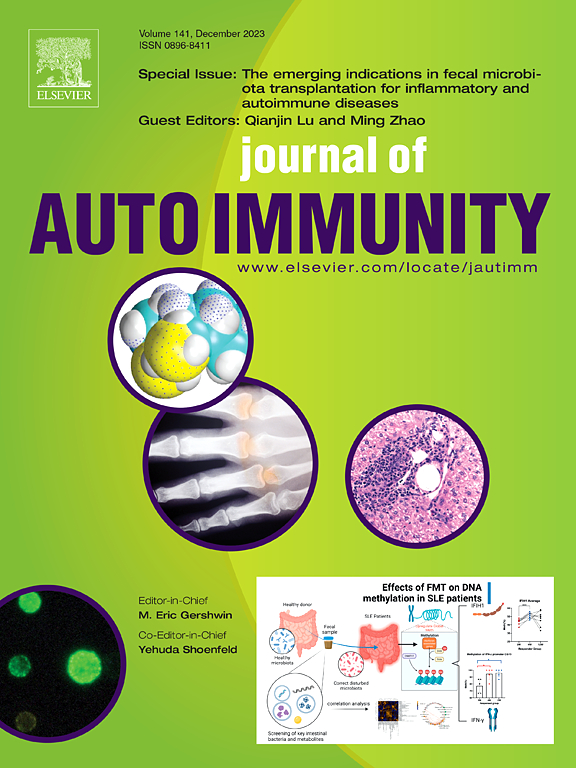Sunscreen use associated with elevated prevalence of anti-nuclear antibodies in U.S. adults
IF 7
1区 医学
Q1 IMMUNOLOGY
引用次数: 0
Abstract
Background
Antinuclear antibody (ANA) prevalence in the U.S. population increased from 1988 to 2012, especially in white and more educated individuals. In adults ages 20–39 years from the National Health and Nutrition Examination Survey (NHANES) 2003–2004 and 2011–2012, ANA prevalence was previously associated with urinary concentrations of a common sunscreen ingredient, benzophenone 3, measured in winter. Spot urines may not capture relevant chronic exposures, thus we examined whether ANA was related to sunscreen use.
Methods
In a cross-sectional study of adults ages 20–59 (N = 416 ANA positive, 2656 ANA negative, by Hep-2 immunofluorescence, 1:80 dilution), we examined associations of ANA with reported sunscreen use when in the sun for 1 h or more. Logistic regression was used to calculate covariate-adjusted prevalence odds ratios (POR) and 95 % Confidence Intervals (CI), overall and stratified by demographic factors, season, and vitamin D. We explored associations and joint effects with other sun protective behaviors and sunburn in the past 12 months.
Results
The association of ANA with sunscreen differed by age (interaction p = 0.004): for ages 20–39, we saw an exposure response (POR 2.61, 95 % CI 1.50, 4.24 for using sunscreen always or most of the time, and POR 1.85; 1.12, 3.05 for less frequent versus never-use; trend p < 0.001). These associations were more apparent in females (interaction p = 0.082), non-Hispanic white and black participants (vs. other race/ethnicity, interaction p = 0.023), and those with sufficient serum vitamin D (≥50 vs. <50 nmol/L, interaction p = 0.001). ANA was not associated with other protective behaviors and not confounded or modified by these behaviors or recent sunburn.
Conclusions
These cross-sectional findings showed frequent sunscreen was associated with ANA in younger adults, supporting the need for replication, and longitudinal studies with detailed exposure histories.
防晒霜的使用与美国成年人抗核抗体流行率升高有关
背景1988年至2012年间,美国人口中的核抗体(ANA)流行率有所上升,尤其是在白人和受教育程度较高的人群中。在2003-2004年和2011-2012年国家健康与营养调查(NHANES)中,年龄在20-39岁的成年人中的ANA流行率与冬季测量的尿液中常见防晒霜成分二苯甲酮3的浓度有关。方法在一项针对 20-59 岁成年人的横断面研究中(通过 Hep-2 免疫荧光,1:80 稀释,N = 416 ANA 阳性,2656 ANA 阴性),我们研究了 ANA 与在阳光下晒 1 小时或更长时间时使用防晒霜的相关性。我们采用逻辑回归法计算了经协方差调整的患病几率比(POR)和 95 % 置信区间(CI),包括总体患病几率比和按人口统计学因素、季节和维生素 D 分层的患病几率比。结果ANA与防晒霜的关系因年龄而异(交互作用 p = 0.004):在 20-39 岁的人群中,我们发现了一种暴露反应(经常或大部分时间使用防晒霜的 POR 为 2.61,95 % CI 为 1.50-4.24 ;较少使用与从不使用的 POR 为 1.85; 1.12-3.05; 趋势 p < 0.001)。这些关联在女性(交互作用 p = 0.082)、非西班牙裔白人和黑人参与者(与其他种族/族裔相比,交互作用 p = 0.023)以及血清维生素 D 充足者(≥50 与 50 nmol/L,交互作用 p = 0.001)中更为明显。结论:这些横断面研究结果表明,经常使用防晒霜与年轻成人的 ANA 有关,因此有必要进行重复研究和具有详细暴露史的纵向研究。
本文章由计算机程序翻译,如有差异,请以英文原文为准。
求助全文
约1分钟内获得全文
求助全文
来源期刊

Journal of autoimmunity
医学-免疫学
CiteScore
27.90
自引率
1.60%
发文量
117
审稿时长
17 days
期刊介绍:
The Journal of Autoimmunity serves as the primary publication for research on various facets of autoimmunity. These include topics such as the mechanism of self-recognition, regulation of autoimmune responses, experimental autoimmune diseases, diagnostic tests for autoantibodies, as well as the epidemiology, pathophysiology, and treatment of autoimmune diseases. While the journal covers a wide range of subjects, it emphasizes papers exploring the genetic, molecular biology, and cellular aspects of the field.
The Journal of Translational Autoimmunity, on the other hand, is a subsidiary journal of the Journal of Autoimmunity. It focuses specifically on translating scientific discoveries in autoimmunity into clinical applications and practical solutions. By highlighting research that bridges the gap between basic science and clinical practice, the Journal of Translational Autoimmunity aims to advance the understanding and treatment of autoimmune diseases.
 求助内容:
求助内容: 应助结果提醒方式:
应助结果提醒方式:


